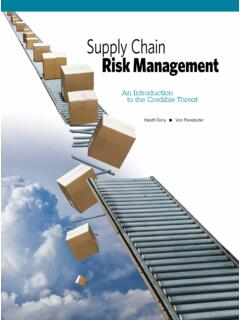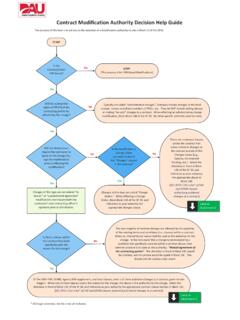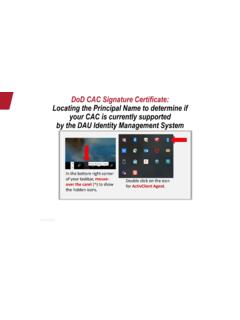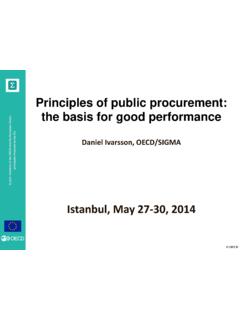Transcription of Performance Based Logistics Guidebook - DAU
1 Performance Based Logistics (PBL) Guidebook Performance Based Logistics (PBL) Guidebook PREFACE The 2016 Release of the PBL Guidebook includes additional lessons learned and implementation guidance intended to support a Program Management Team through the development and execution of PBL arrangements. It is an update to Release 2015. Additions to the 2016 Release are as follows: 1. Updated Frequently Asked Questions and a review of common myths surrounding Performance Based Logistics . 2. New material addressing intellectual property issues, highlighting various strategic considerations surrounding government data rights. 3. Refined data collection phase focused on program specific insights generated through analysis. 4. Additional appendix highlighting specific considerations and steps a Program Management Team should address prior to beginning the implementation process.
2 Throughout the document, key insights for success were included leveraging the experiences and lessons learned from ongoing PBL initiatives. Overall, the edits and enhancements are intended to improve the usability of the Guidebook and maintain updated content for the successful implementation of PBL arrangements. Introduction Better Buying Power (BBP) identified seven focus areas to achieve greater efficiency and productivity in defense spending. Based on proven success, Performance - Based Logistics (PBL) is included within BBP area three Incentivize Productivity and Innovation in Industry and Government. BBP emphasized that delivering better value to the taxpayer and Warfighter is the goal. In support of BBP , the Office of the Assistant Secretary of Defense for Logistics and Materiel Readiness (OASD (L&MR)), in collaboration with the Services and Defense Acquisition University (DAU), prepared this PBL Guidebook .
3 This document is for Component Leadership, Program Executive Officers (PEO), Program Managers (PM), Product Support Managers (PSM), Logistics Managers, Contracting Officers, Financial Managers, System Engineers, and other parties responsible for developing and executing product support strategies. It is a consolidated resource that leverages Department of Defense Instructions (DoDI) and other guidebooks, and uses the Product Support Business Model as an organizing construct for PBL best practices, processes, and supporting documentation needed to craft effective PBL arrangements. Performance Based Logistics (PBL) Guidebook How to Use This Document This Guidebook is divided into three major sections, each with various subsections. Section One provides background information that addresses the history of PBL, how it works, and considerations for its application across the various phases of a program s life cycle.
4 Section Two complements and expands upon the DoD 12-Step Product Support Strategy Process Model provided in the PSM Guidebook for systems, subsystems, or components. The steps in Section Two are intended to assist the reader in successfully implementing a PBL arrangement with the recognition that, depending on the life cycle phase, not all steps may be applicable and all are tailorable depending on the unique requirements of a given program. Section Three is the appendices. This document provides hardware-focused examples, but the steps in this document may also be applied to Major Automated Information System (MAIS) programs. As an example for the reader to follow in developing and implementing a PBL arrangement, a notional Generic Subsystem (GSS) (that implements a PBL solution with a commercial Original Equipment Manufacturer (OEM)) is included throughout the Guidebook .
5 Table of Contents PREFACE 2 Introduction 2 How to Use This 3 1. Background 6 PBL Defined .. 6 Policy and Guidance Overview .. 6 History of PBL .. 7 How Performance - Based Arrangements Work .. 10 Aligning the Interests of Government and Industry .. 13 Product Support Business Model and PBL: An Enabling Function across a Program/Product Life Cycle .. 13 2. 12 Step Standard and Repeatable Approach to PBL .. 20 Step 1. Integrate Warfighter Requirements & Support .. 21 Step 2. Form the Product Support Management IPT .. 25 Step 3. Baseline the 29 Step 4. Identify/Refine Performance Outcomes .. 40 Step 5. Business Case Analysis .. 45 Step 6. Product Support Value Analysis .. 54 Step 7. Determine Support Methods(s) .. 69 Step 8. Designate Product Support Integrator(s) (PSI) .. 72 Step 9.
6 Identify Product Support Provider(s) (PSP) .. 73 Step 10. Identify/Refine Financial 75 Step 11. Establish/Refine Product Support Arrangements .. 80 Step 12. Implement and Assess .. 88 3. Resources and Appendixes .. 90 Performance Based Logistics (PBL) Guidebook Resource A: Frequently Asked Questions (FAQ) .. 91 Resource B: 100 Resource C: Acronyms .. 105 Resource D: Bibliography .. 108 Appendix A: PBL Tenets - Characteristics that Drive Optimal Outcomes .. 110 Appendix B: Generic Subsystem PSM IPT Charter Example .. 113 Appendix C: Knowledge Transfer and PSM IPT Training .. 116 Appendix D: DAU s PBL Training and Knowledge-Sharing Resources .. 119 Appendix E: Expansion of Key Considerations to Baseline the System . 121 Appendix F: PBL Metrics .. 126 Appendix G: Calculating Weights from Pairwise Comparison Votes.
7 141 Appendix H: Other Sources for Cost Estimation .. 141 Appendix I: PBL Contract Example .. 143 Appendix J: Pre-Implementation Considerations for a Sub-System PSM164 List of Tables Table 4: PBL Key Considerations .. 16 List of Figures No table of contents entries found. 1. Background PBL Defined PBL is synonymous with Performance - Based life cycle product support, where outcomes are acquired through Performance - Based arrangements that deliver Warfighter requirements and incentivize product support providers to reduce costs through innovation. These arrangements are contracts with industry or intragovernmental A PBL arrangement is not synonymous with Contractor Logistics Support (CLS). CLS signifies the who of providing support, not the how of the business model. CLS is support provided by a contractor, whether the arrangement is structured around Warfighter outcomes with associated incentives or not.
8 PBL arrangements, on the other hand, are tied to Warfighter outcomes and integrate the various product support activities ( , supply support, sustaining engineering, maintenance, etc.) of the supply chain with appropriate incentives and metrics. In addition, PBL focuses on combining best practices of both Government and industry. 1 PBL description from the ASD L&MR Performance - Based Logistics Comprehensive Guidance Memorandum DTD 22 Nov 13 Performance Based Logistics (PBL) Guidebook Policy and Guidance Overview PBL has been the preferred sustainment strategy since the 2001 Quadrennial Defense Review (QDR) stating, DoD will implement PBL to compress the supply chain and improve readiness for major weapons systems and commodities. Since then, it has been both DoD policy2 and a strategic priority to increase the use of Performance - Based arrangements to deliver product support solutions3 that satisfy Warfighter requirements.
9 The policies governing these strategies have gone through several iterations since 2001, but the intent has remained the same: to provide life cycle product support that delivers needed reliability and availability at a reduced cost while complying with directives, such as inventory accountability within a Government Accountable Property System of Record, and maximizing the use of existing Government-owned inventory when purchasing through a PBL. A detailed listing of the Product Support and PBL policies, guidance, and tools can be found at: and Performance Based Contracting (Arrangements) As outlined in the Federal Acquisition Regulation (FAR) Subpart Performance Based Contracting (PBC). PBC is a contracting method intended to ensure required Performance quality levels are achieved, and total payment is related to, the degree to which Performance meets contract standards.
10 To obtain these objectives, Performance Based contracts should: Describe requirements in terms of results to be obtained rather than the methods of Performance . In other words the task should describe the desired result or outcome rather than how work is to be performed. Use measurable Performance standards (in terms of quality, timeliness, quantity, etc.). Ideally these standards should be expressed in objective measures using indicators such that the Performance measure is achievable and independently verifiable. Specify procedures for reductions of fee for a cost type contract or reductions to the price of a fixed price contract when services are not performed or do not meet contract requirements. These financial penalties provide incentives for satisfactory contract Performance according to the desired outcome and Performance standards.
















